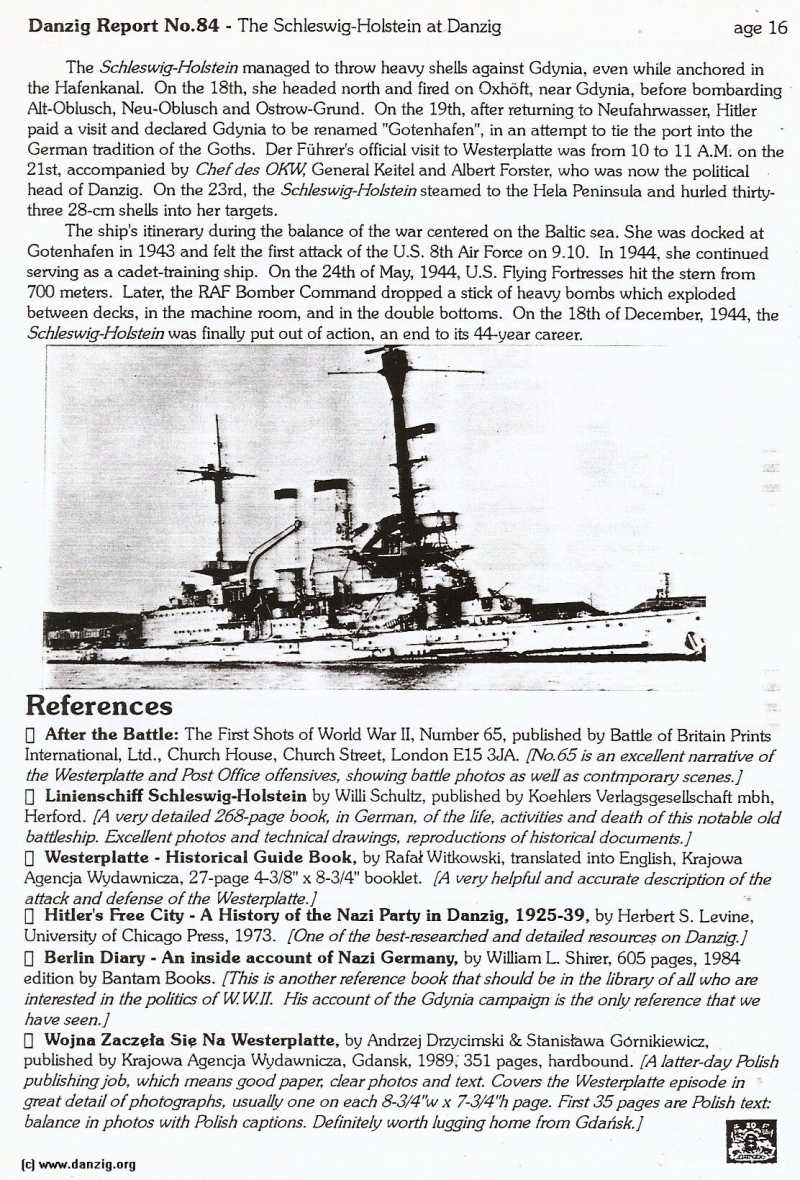
The Schies wig-Ho/stein managed to throw heavy shells against Gdynia, even while anchored in the Hafenkanal. On the 18th, she headed north and fired on Oxhôft, near Gdynia, before bombarding Alt-Oblusch, Neu-Oblusch and Ostrow-Grund. On the 19th, after returning to Neufahrwasser, Hitler paid a visit and declared Gdynia to be renamed “Gotenhafen”, in an attempt to tie the port into the German tradition of the Goths. Der Führer’s official visit to Westerplatte was from 10 to 11 A.M. on the 2 1st, accompanied by Chef des 0KW General Keitel and Albert Forster, who was now the political head of Danzig. On the 23rd, the Schleswig-Holstein steamed to the Hela Peninsula and hurled thirty- three 28-cm shells into her targets.
The ship’s itinerary during the balance of the war centered on the Baltic sea. She was docked at Gotenhafen in 1943 and felt the first attack of the U.S. 8th Air Force on 9.10. In 1944, she continued serving as a cadet-training ship. On the 24th of May, 1944, U.S. Flying Fortresses hit the stern from 700 meters. Later, the RAF Bomber Command dropped a stick of heavy bombs which exploded between decks, in the machine room, and in the double bottoms. On the 18th of December, 1944, the SchJeswi’-Holstein was finally put out of action, an end to its 44-year career.
References
After the Battle: The First Shots of World War II, Number 65, published by Battle of Britain Prints International, Ltd., Church House, Church Street, London E15 3JA [No.65/s an excellent narrative of the Wesferplatte and Post Office offensives, showing battle photos as well as contmporary scenes.]
Linienschiff Schleswig-Holstein by Willi Schultz, published by Koehiers Verlagsgesellschaft mbh, Herford. [A very detailed 268-page book, in German, of the life, activities and death of this notable old battleship. Excellent photos and technical drawings, reproductions of historical documents.]
Westerplatte - Historical Guide Book, by Rafak Witkowski, translated into English, Krajowa Agencja Wydawnicza, 27-page 4-3/8” x 8-3/4” booklet. [A very helpful and accurate description of the attack and defense of the Westerplatte.J
Hitler’s Free City - A History of the Nazi Party in Danzig, 1925-39, by Herbert S. Levine, University of Chicago Press, 1973. [One of the best-reseazuhed and detailed resouiues on Danzig.J
Berlin Diary - An inside account of Nazi Germany, by William L. Shirer, 605 pages, 1984 edition by Bantam Books. [This is another reference book that should be in the library of all who are interested in the politics of W WI!. His account of the Gdynia campaign is th only reference that we have seen.]
Wojna Zacz1a Si€ Na Westerplatte, by Andrzej Drzycimski & Staniswa GOrnikiewicz, published by Krajowa Agencja Wydawnicza, Gdansk, 1989; 351 pages, hardbound. [i4 latter-day Polish publishing job, which means good paper clear photos and text. Covers the Westerplatte episode in great detail of photographs, usually one on each 8-3/4’W x 7-3/4”h page. Fi,t 35 pages are Polish text: balance in photos with Polish captions. Definitely worth lugging home fzvm Gdaiisk.
Danzig Report Vol. 1 - Nr. 84 - July - August - Sept - 1994, Page 16.
Hits: 3236
Added: 09/07/2015
Copyright: 2025 Danzig.org

